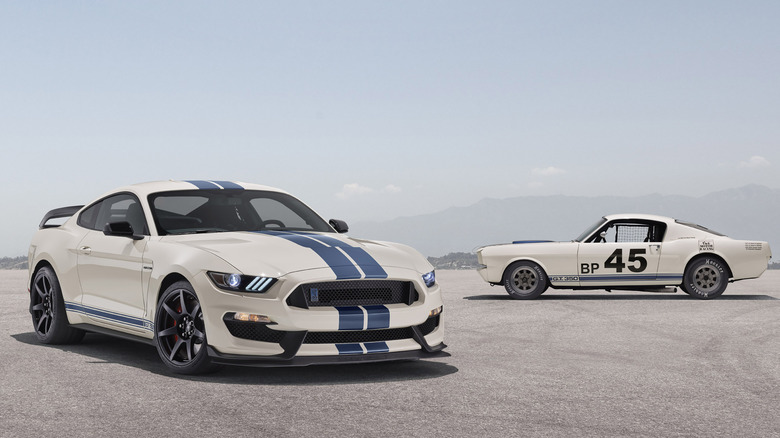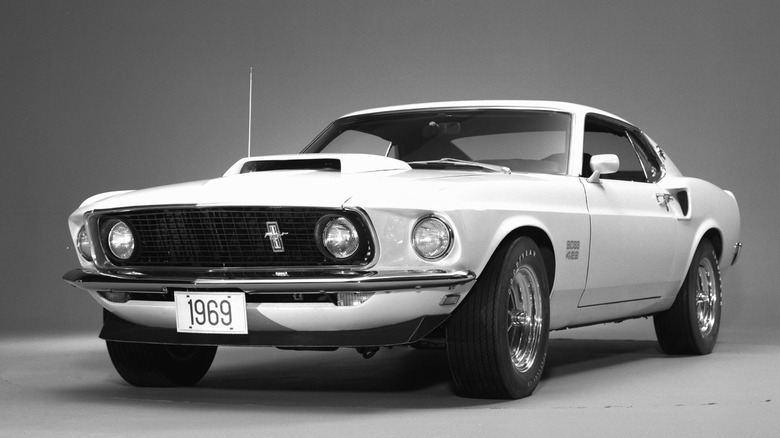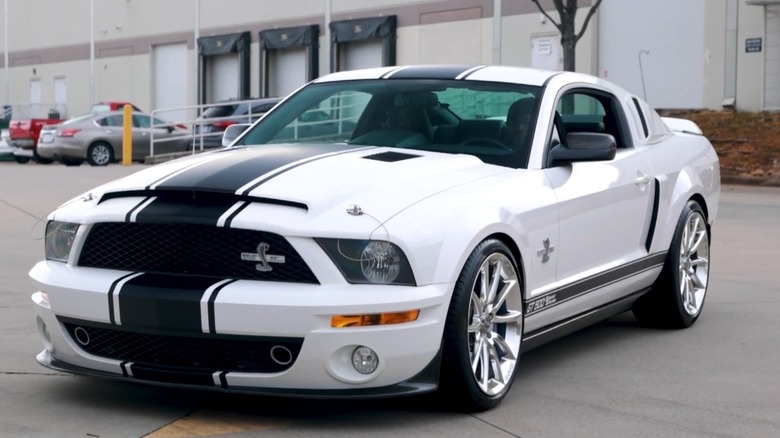5 Of The Best-Looking Mustangs Ford Has Ever Made
If there's one American car which has captivated the hearts of automotive enthusiasts worldwide, it's the Ford Mustang. And that's no accident — the compact size, budget-conscious price-point, choice of potent powerplants, all these factors and more add up to a truly exceptional vehicle. So much so, in fact, that an entire subclass grew from its development: namely, the Pony Car. Cars in this category feature a certain ubiquitous appearance, typically boasting midsize two-door platforms, small-block V8s, and so on.
This classic style first gained real traction in the United States with the Mustang's original debut, and the first Pony Car has remained in production ever since. With such a long production run, naturally the Mustang underwent multiple generations, dozens of facelifts, and even greater amounts of variety accounting for special editions. As such, there's virtually guaranteed to be a Mustang to suit most enthusiasts' specific tastes, and this list is by far incomplete as a result.
Another caveat is that this list will only account for Mustangs that left Ford and Ford-subsidiary factories as-is, so no modified vehicles, Saleen models, concept cars, and so on. Every Mustang will also be compared with its contemporaries, as opposed to a modern perspective; thus, a mid-'60s car will be judged on mid-'60s standards, for example. Lastly, being that this is an opinion-piece, we acknowledge that it's hardly fair to judge such a broad range of vehicles with a subjective standard; there are countless other Mustangs that remain head-turners. Every Ford Mustang body style features its own unique styling choices, and some preferences may not align. Because of their disparity, this list is in no particular order, and instead views each Mustang in relation to other cars of its era. All that aside, let's dive into the list.
1966 Shelby GT350
If you ask a layman to picture a classic Mustang in their mind, this is probably what pops in. That level of staying-power alone is enough to earn this vehicle a place on the list; its lines are so iconically-Mustang as to be utterly unmistakeable. Even just viewing its silhouette, you know exactly what this vehicle is and what level of performance to expect from it. In the mid-1960s, its striking image automatically granted it a seat at the muscle car table alongside giants like the Pontiac GTO. Moreover, it helped popularize various small-block racing series, most prominently SCCA circuit racing, and remains one of the most iconic limited-edition Mustangs every Ford fan will likely recognize.
These cars represented one of the earliest examples of the homologation special, with an initial batch of 110 examples offered in Wimbledon White with Guardsman Blue rocker stripes, stripped interior appointments, and racing-focused tuning. By 1966, the Shelby Mustang became so sensational that Ford offered it in a more street-oriented format. The Mustang name was dropped, leaving its official name as the 1966 Shelby GT350, and it was fitted with various improvements over the 1965 model year. Ford now offered the GT350 in a variety of colors, such as the famous Raven Black of Hertz fame, Candy Apple Red, Sapphire Blue Metallic, and more.
Stylistically, this Mustang represents the undisputed pinnacle of the original production run between mid-1964 to 1967. It combines all the hallmarks into one package: fastback body, optional Le Mans stripes, functional hood scoop, triple-taillights, functional but well-finished interior, and so on. Regardless of context or era, it remains an instant classic from its looks alone, which both flawlessly communicate its purpose and bear handsome proportions that suit many enthusiasts' tastes.
2024 Mustang Dark Horse
Admittedly, there are few vehicles in general, much less Mustangs, which can follow up with the benchmark set by the classic Shelby GT350. Its closest modern equivalent, however, offers a compelling argument for a Mustang that's just as bold and effortlessly-intimidating to view: that being the 2024 Dark Horse, the next step up from the Mustang GT. And it's among the fastest regular-production Mustangs as well, boasting an impressive top speed and quarter-mile time. As far as styling goes, like the GT350, the Dark Horse is somewhat more subdued than more extreme examples such as the GTD, which is effectively a GT3 race car with no livery. Conversely, the Dark Horse is very much a road going Mustang, with its racing counterpart, the Dark Horse R, sharing most of its design elements.
These elements help accentuate its more racing-focused nature, featuring bold aesthetics courtesy of aerodynamic devices like the prominent rear wing, rear diffuser, wide wheel arches housing bespoke rims, and aggressive chin splitter. Unlike some other grand-tourers, its major styling cues don't lean heavily on the angry-face look, but rather focus more on function-over-form. The large grille inlets, hood vents, and so on grant a distinct style that fits nicely with the traditional Mustang while being thoroughly modern.
Overall, the Dark Horse is a relative newcomer to the Mustang lineup, though its track-focused styling has already garnered praise for its ominous front end, sweeping lines, and interior appointments. Appropriate to the name, it looks particularly slick in dark colors, where the muted front end looks truly menacing.
1969 Mustang Boss 429
This is likely the most intimidating-looking Mustang ever built. Seeing this grille in your rearview mirror is an experience, with its tall arrowhead physique looking more like a curled fist than a car. It's no wonder, then, that this machine found a new audience with the release of "John Wick," where the titular character drives a Boss 429 with custom paintwork — or, rather, a crafted mock-up of a real Boss 429. The real thing, being a homologation-special, featured special badging, interior appointments, and was only available with a manual transmission — none of which were present in the movie car. Nevertheless, the Mach 1 stand-in for the movies, not to mention the Boss 429 itself, remains an incredible treat to look at.
The distinctive feature of the Boss 429 over the previous Mustang iterations is its size. You'd be forgiven for believing that this car is of a different platform than the mid-1964, but in reality the original generation spanned until 1973. However, it shares little in common with its predecessors, apart from the general body type; the Boss 429 is wider, with a far beefier front-end to accommodate the big-block under the hood, and it features true muscle car proportions.
This was an era in which most high-end vehicles more closely resembled Hotwheels, such as the Pontiac GTO "Judge," Plymouth Hemi 'Cuda, the SS Chevrolets, and more. Taken in context, the Boss 429 combines that ubiquitous fastback aesthetic that made the Mustang famous and combines it with the contemporary style in a way that works in 1969 and 2025 equally well. That's no easy feat for any vehicle, and certainly not one facing stiff competition during the golden age of the muscle era.
2016 Shelby GT350R
Speaking of iconic designs, the 2016 Shelby GT350R takes everything that the prior S197 Shelby Mustang had going for it and multiplied it by two. It now featured an outstanding combination of muscle, racing, and road going design cues, with its distinctive front fascia marked by that strong chin, menacing headlights, and bright red accents lining the racing stripes — and yes, of course it has racing stripes. It's a Shelby.
This car represents the full package: it looks mean, and that's because it is mean. The GT350R is a track-focused monster, featuring a flat-plane crank V8 that revs to a healthy 8,000 rpm, stiff suspension, upgraded brakes, six-speed manual, and more. It certainly looks the part as well, with just as distinctive and numerous aerodynamic elements as the Dark Horse that followed: namely, the rear wing, front splitter, and diffuser. Its lower profile betrays its characteristic road-hugging ride quality, emphasizing width and stance more than the standard Mustang. In effect, it's an effortless design exercise combining the handsome GT with the svelte racing variants, looking more like a Mustang equivalent of something like a Porsche 911 GT3 RS.
There are plenty of Mustangs with similarly-subtle design improvements, such as the 1993 and 1994 SVT Cobra, and 1973 Mach 1. Moreover, there are those with bolder and more intimidating looks; many of the most powerful Shelby models ever count among these ranks. The 2016 GT350R, however, is both subtle and decisive; enthusiasts will look at it and know it's a serious machine, built for serious purposes, yet it doesn't compromise the smooth lines we recognize on modern Mustangs.
2007 Shelby GT500 Super Snake
This car is arguably one of the few Mustangs that comes close to the Boss 429 in terms of front-end design. Its styling is both instantly-recognizable and functional, much like the original Shelby Mustangs, combined with the muscular performance to back it up. The massive fitted rims and low-profile tires truly complete the ensemble, granting the 2007 Shelby GT500 Super Snake a uniquely-stanced appearance over contemporaries.
This Mustang comes together more as an ensemble than anything, honoring the Shelby racing lineage more than the Mustang itself. More specifically, its primary influence is the 1968 GT500, one of the cars that defined Carroll Shelby's legacy. To this end, it borrows multiple design cues from earlier models as well, such as the window louvres present on the original 1965 Shelby GT350, and the roll hoop of the 1968 GT500 in the convertible variant. The hood features a prominent scoop just above the grille, reminiscent of the 1968 Shelby GT500KR, or "King of the Road." The grille itself also slants inward in a trapezoid, like the GT500KR's grille. The rear end houses a fascia emulating the typical Shelby taillight pattern — the list goes on. Put simply, the Super Snake takes all the iconic elements of prior Shelby Mustangs and wraps them up in a modern muscle car package.
The Super Snake debuted alongside the "tamer" GT500 as Ford's official revival of the branding, wearing bright-red with its iconic racing stripes at the 2005 New York International Auto Show. And while much of automotive culture has shifted gears in the past 20 years, the styling of this machine remains one of the most striking regular-production cars that hasn't earned a "classic" moniker, period, let alone Mustangs.





